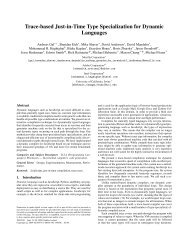compressed.tracemonkey-pldi-09
Create successful ePaper yourself
Turn your PDF publications into a flip-book with our unique Google optimized e-Paper software.
v0 := ld state[748] // load primes from the trace activation record<br />
st sp[0], v0 // store primes to interpreter stack<br />
v1 := ld state[764] // load k from the trace activation record<br />
v2 := i2f(v1)<br />
// convert k from int to double<br />
st sp[8], v1 // store k to interpreter stack<br />
st sp[16], 0 // store false to interpreter stack<br />
v3 := ld v0[4]<br />
// load class word for primes<br />
v4 := and v3, -4 // mask out object class tag for primes<br />
v5 := eq v4, Array // test whether primes is an array<br />
xf v5<br />
// side exit if v5 is false<br />
v6 := js_Array_set(v0, v2, false) // call function to set array element<br />
v7 := eq v6, 0<br />
// test return value from call<br />
xt v7<br />
// side exit if js_Array_set returns false.<br />
Figure 3. LIR snippet for sample program. This is the LIR recorded for line 5 of the sample program in Figure 1. The LIR encodes<br />
the semantics in SSA form using temporary variables. The LIR also encodes all the stores that the interpreter would do to its data stack.<br />
Sometimes these stores can be optimized away as the stack locations are live only on exits to the interpreter. Finally, the LIR records guards<br />
and side exits to verify the assumptions made in this recording: that primes is an array and that the call to set its element succeeds.<br />
mov edx, ebx(748)<br />
mov edi(0), edx<br />
mov esi, ebx(764)<br />
mov edi(8), esi<br />
mov edi(16), 0<br />
mov eax, edx(4)<br />
and eax, -4<br />
cmp eax, Array<br />
jne side_exit_1<br />
sub esp, 8<br />
push false<br />
push esi<br />
call js_Array_set<br />
add esp, 8<br />
mov ecx, ebx<br />
test eax, eax<br />
je side_exit_2<br />
...<br />
side_exit_1:<br />
mov ecx, ebp(-4)<br />
mov esp, ebp<br />
jmp epilog<br />
// load primes from the trace activation record<br />
// (*) store primes to interpreter stack<br />
// load k from the trace activation record<br />
// (*) store k to interpreter stack<br />
// (*) store false to interpreter stack<br />
// (*) load object class word for primes<br />
// (*) mask out object class tag for primes<br />
// (*) test whether primes is an array<br />
// (*) side exit if primes is not an array<br />
// bump stack for call alignment convention<br />
// push last argument for call<br />
// push first argument for call<br />
// call function to set array element<br />
// clean up extra stack space<br />
// (*) created by register allocator<br />
// (*) test return value of js_Array_set<br />
// (*) side exit if call failed<br />
// restore ecx<br />
// restore esp<br />
// jump to ret statement<br />
Figure 4. x86 snippet for sample program. This is the x86 code compiled from the LIR snippet in Figure 3. Most LIR instructions compile<br />
to a single x86 instruction. Instructions marked with (*) would be omitted by an idealized compiler that knew that none of the side exits<br />
would ever be taken. The 17 instructions generated by the compiler compare favorably with the 100+ instructions that the interpreter would<br />
execute for the same code snippet, including 4 indirect jumps.<br />
i=2. This is the first iteration of the outer loop. The loop on<br />
lines 4-5 becomes hot on its second iteration, so TraceMonkey enters<br />
recording mode on line 4. In recording mode, TraceMonkey<br />
records the code along the trace in a low-level compiler intermediate<br />
representation we call LIR. The LIR trace encodes all the operations<br />
performed and the types of all operands. The LIR trace also<br />
encodes guards, which are checks that verify that the control flow<br />
and types are identical to those observed during trace recording.<br />
Thus, on later executions, if and only if all guards are passed, the<br />
trace has the required program semantics.<br />
TraceMonkey stops recording when execution returns to the<br />
loop header or exits the loop. In this case, execution returns to the<br />
loop header on line 4.<br />
After recording is finished, TraceMonkey compiles the trace to<br />
native code using the recorded type information for optimization.<br />
The result is a native code fragment that can be entered if the<br />
interpreter PC and the types of values match those observed when<br />
trace recording was started. The first trace in our example, T 45,<br />
covers lines 4 and 5. This trace can be entered if the PC is at line 4,<br />
i and k are integers, and primes is an object. After compiling T 45,<br />
TraceMonkey returns to the interpreter and loops back to line 1.<br />
i=3. Now the loop header at line 1 has become hot, so Trace-<br />
Monkey starts recording. When recording reaches line 4, Trace-<br />
Monkey observes that it has reached an inner loop header that already<br />
has a compiled trace, so TraceMonkey attempts to nest the<br />
inner loop inside the current trace. The first step is to call the inner<br />
trace as a subroutine. This executes the loop on line 4 to completion<br />
and then returns to the recorder. TraceMonkey verifies that the call<br />
was successful and then records the call to the inner trace as part of<br />
the current trace. Recording continues until execution reaches line<br />
1, and at which point TraceMonkey finishes and compiles a trace<br />
for the outer loop, T 16.



